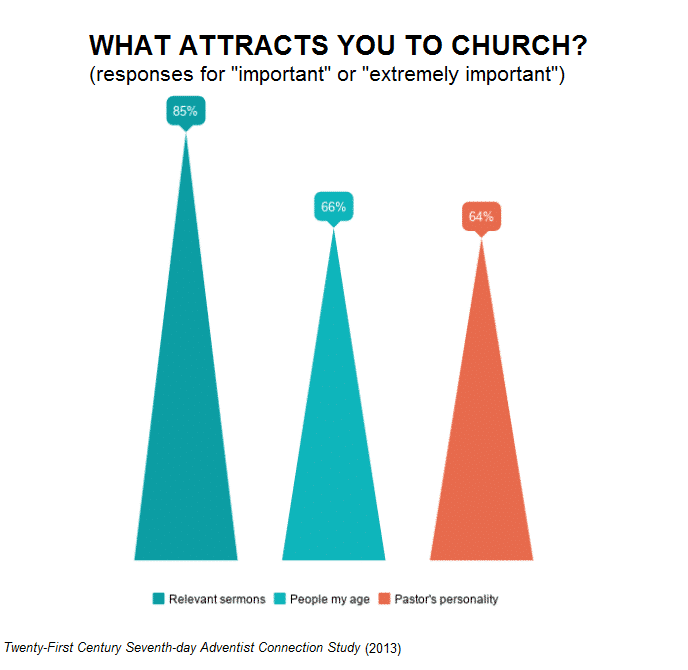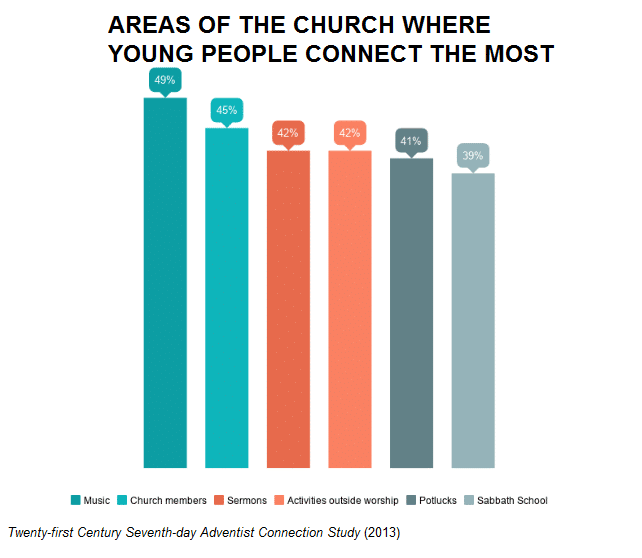Research on the subject of church warmth suggests that relationships are central to the “church” experience, but there appears to be a mix of conflict and lack of connection across various aspects of church life that have driven many of our church’s young people away from it. Even with a superficial understanding of the role that relationships play in a young person’s life, it seems fair to suggest that church leaders ought to be paying more attention to how connected, or otherwise, their youth and young adults feel at church. It may be that young people stop attending their church simply because they feel alone in it.
If that is the case, this issue would not be unique to the SDA Church. Research on faith, culture, and millennials conducted in 2017 by the Barna Group suggests that the millennial generation (born between 1981-1996) is the loneliest generation in the last four, as one in five millennial adults surveyed (25%) says they regularly or often feel lonely. With the characteristically transitory period that young adults experience soon after college and into their early career, it’s not far-fetched to question the longevity of friendships born in work environments. At the very least, it’s certainly not ungrounded to suspect that the number of friendships that start through church may be on the decline, as the number of millennials who have left church increases.
Can a local church prevent the loss of young people and ensure that they feel more connected to church?
The answer might be in the 21st Century Seventh-day Adventist Connection Study (21st CCS, 2012-2013) commissioned by the General Conference and lead by Dr. Douglas Jacobs from Southern Adventist University along with a team of researchers from the Oakwood and Southern Adventist Universities. The participants were millennials (59% under 30 years of age and 32% between 30-34) who were recent graduates from Oakwood University, Southern University, and Pacific Union College. The research findings gave us insight into what helps young adults feel connected to their local SDA church.
We have written several blogs that summarizes some of the findings of the 21st CCS in relation to what SDA young adults think about our doctrines and how those beliefs correlated with their devotional life/lifestyle (found here, here, and here), their engagement in church life, and their age of baptism. This time we will look at the aspects of church that young adults reportedly connect with the most.
When asked what attracted them to their church the most, respondents said that the most important aspect was how relevant the sermons were, with 85% of them saying it was important or extremely important. The other prominent qualities of the churches that attracted young people was having people their age at church (66% saying it was important or extremely important) and the personality of the church’s pastor (64% said it was important or extremely important). Interestingly enough, the least important factor that attracted them to church was the need to have members of similar ethnicity in attendance.

One thing is evident so far: young people are listening at church. The fact that the pastor and sermons both scored so highly as factors that attracted survey participants to their specific churches suggests that young people are at church not only for their social network, but they are also paying attention to the things they hear spoken from the pulpit. It would be useful for church leaders to keep their young audience in mind when they prepare sermons and to do so in a way that encourages and challenges them to think. (For more discussion on church “thinking climate,” click here.)
When asked to select the areas of church where they connect the most, participants said that music (49%), was the most important one, followed closely by other church members (45%). The third highest choice was “activities outside of church service (42%) which excludes community outreach, potlucks, young adult ministries, and small groups.

Sermons were also at 42%, which is important to note especially as they scored so highly in the question discussed above. Potlucks themselves were pretty popular at 41% and Sabbath School was next on the list with 40% .
Findings from another study on young people, Valuegenesis Europe, also show the important role of preaching. Young people who feel that sermons are relevant to their lives are eight times more likely to be in the church in twenty years. If they think that their spiritual needs are met in their churches, this probability is five times higher than if their needs are not met. Additionally, if they are in supportive congregations where they can apply their spiritual gifts and be involved in church life, they 2.6 times more likely stay in the church in twenty years. (Spes Christiana, Valuegenesis Europe, vol. 24, 2013, 79-180).
Interestingly, the 21st Century Seventh-day Adventist Connection Study indicates that about half of the respondents are single, mostly childless and a significant number of them are in graduate school. These factors indicate that the young people surveyed are not “settled” and the report authors suggest that, given their data on this sample’s church membership and attendance, the transitory nature of this period in their lives is a significantly influential factor that determines whether or not young people are able to connect to a church. It is important for churches to consider that the upcoming generation is increasingly mobile and this new reality may begin to shape the way that millennials experience and interact with church in the future.
A key aspect of church that can be improved is the sermon: pastors should be intentional about making sermons more interesting to listen to, and making them applicable across generations. Also, there seems to be an opportunity for young people to connect to their local church service through music and church leaders should see incorporating different worship styles and musical opportunities into their service as a ministry for reaching out to young people. An additional area that emerged from this report is the importance for church members to be friendly and warm towards each other, especially towards young people. Often, right after graduation, young people are venturing into a solitary journey of new jobs and cities: many would benefit from local churches that, understanding this, readily embraced them and made them feel less alone. In this way we may fulfill the mission to be “like-minded, be sympathetic, love one another, be compassionate and humble” towards the least of those around us (1 Peter 3:8).
For the full report and its executive summary, click here.
Creado en colaboración con el Instituto del Ministerio de la Iglesia (Institute of Church Ministry).
Published by ASTR

